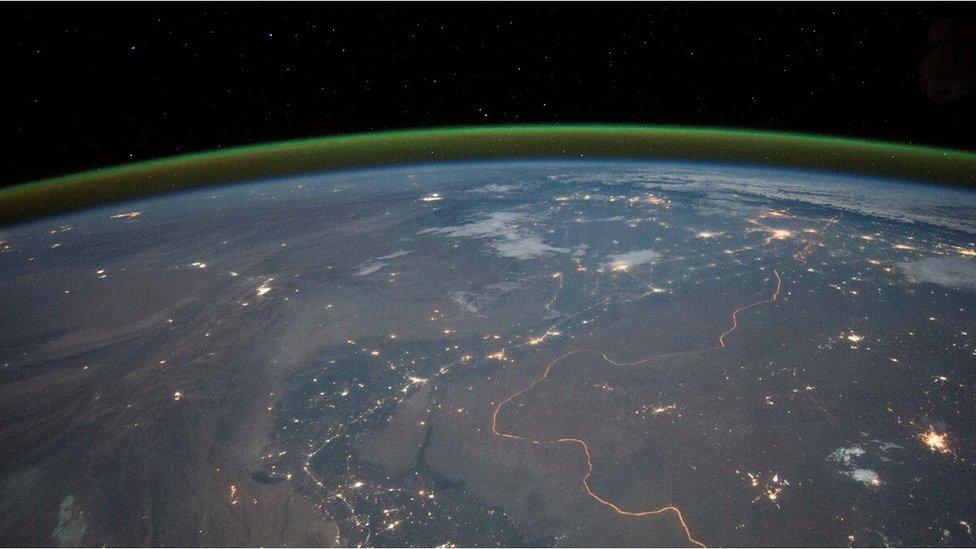Mars: Green glow detected on the Red Planet
- Published

At Earth, astronauts see a green glow as they look edge-on into our atmosphere
Scientists have identified a green light in the atmosphere of Mars.
A similar glow is sometimes seen by astronauts on the space station when they look to the Earth's limb.
The glow comes from oxygen atoms when they're excited by sunlight.
The phenomenon has long been predicted to occur on other planets, but the Trace Gas Orbiter (TGO) - a joint European-Russian satellite at Mars - is the first to make the observation beyond Earth.
"It's a nice result," said Dr Manish Patel from the UK's Open University.
"You'd never plan a mission to go look for this kind of thing. Today, we have to be very clear about the science we're going to do before we get to Mars. But having got there, we thought, 'well, let's have a look'. And it worked."
To be clear, this is different to classic auroras like the Northern and Southern Lights.
These emissions are the consequence of collisions between atmospheric molecules and charged particles that are racing away from the Sun. On Earth, this type of interaction is heavily influenced by our planet's strong magnetic field, which pulls those particles down on to the poles.

Artist's impression of the TGO at Mars: The spectrometer is able to identify the source of the light
Auroras are not focussed in quite the same way on Mars because this world doesn't have a global magnetic field, but such emissions nonetheless exist and have already been observed.
The green glow seen by astronauts at the edge of the Earth - and now by the TGO at Mars - has a separate origin. It's sunlight that's doing the work. Oxygen atoms are raised to a higher energy level and when they fall back to their resting state, they produce the tell-tale green emission.
Earth has abundant oxygen in its atmosphere. But on Mars it's largely present only as a breakdown product of carbon dioxide. Sunlight will free one of the oxygen atoms in CO2, and it's the transition of this atom that's glowing green on the Red Planet.
The TGO detects the excited oxygen not with an imaging camera (hence no pretty pictures) but with its Nomad spectrometer package. This instrument sees the oxygen at very particular altitudes.
In a paper published in the journal Nature Astronomy, external, these altitudes are at 80km and 120km above the surface. The precise altitudes are dependent on the pressure of CO2.
"And by looking at the altitudes of where this emission is, you can actually tell the thickness of the atmosphere and how it's varying," explained Dr Patel.
"So, if you were to keep observing this phenomenon, you could see the height of the atmosphere change, something it does for example when it heats up during dust storms. This is an issue we face when we try to land on Mars because we're never quite sure just how thick the atmosphere will be when we plough through it to get to the surface."
Theoretically, therefore, you could use observations of the green glow to help inform the models that guide the entry, descent and landing of Mars probes.
The glow at Mars was detected by the TGO's Nomad instrument, which is led by the Royal Belgian Institute for Space Aeronomy (IASB-BIRA). Dr Patel is the co-principal investigator on Nomad's ultraviolet and visible spectrometer.
Jonathan.Amos-INTERNET@bbc.co.uk, external and follow me on Twitter: @BBCAmos, external